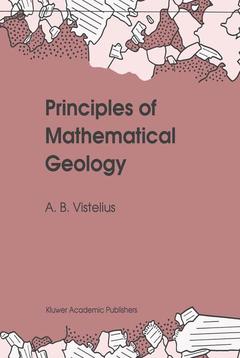Description
Principles of Mathematical Geology, Softcover reprint of the original 1st ed. 1992
Author: Vistelius A.B.
Language: English
Subjects for Principles of Mathematical Geology:
Publication date: 11-2012
477 p. · 16x24 cm · Paperback
477 p. · 16x24 cm · Paperback
Description
/li>Contents
/li>
Preface to the English edition xiii Basic notations xv Introduction xvii amPl'ER 1. Mathenatical Geology and the Developnent of Geological Sciences 1 1. 1 Introduction 1 1. 2 Developnent of geology and the change of paradigms 2 1. 3 Organization of the mediun and typical structures 8 1. 4 statement of the problem: the role of models in the search for solutions 14 1. 5 Mathematical geology and its developnent 19 References 23 amPTER II. Probability Space and Randan Variables 29 11. 1 Introduction 29 11. 2 Discrete space of elementary events 29 11. 2. 1 Probability space 30 II. 2 ? 2 Randan variabl es 33 11. 3 Kolroogorov's axian; The Lebesgue integral 35 II. 3. 1 Probability space and randan variables 36 I 1. 3. 2 The Lebesgue integral 40 II. 3. 3 Nunerical characteristics of raman variables 44 II. 4 ~les of distributions of randan variables 46 II. 4. 1 Discrete distributions 46 II. 4. 2 Absolutely continuous distributions 51 II. 5 Vector randan variables 58 II. 5. 1 Product of probability spaces 58 II. 5. 2 Distribution of vector randan variables 60 II. 5. 3 Olaracteristics of vector randan variables 65 11. 5. 4 Exanples of distributions of vector raman variabl es 69 II . 5. 5 Conditional distributions with respect to randan variables 81 II. 6 Transfomations of randan variables 90 11. 6. 1 Linear transfomations 91 II. 6. 2 Sane non-linear transfomations 95 11. 6.
I. Mathematical Geology and the Development of Geological Sciences.- I.1 Introduction.- I.2 Development of geology and the change of paradigms.- I.3 Organization of the medium and typical structures.- I.4 Statement of the problem: the role of models in the search for solutions.- I.5 Mathematical geology and its development.- References.- II. Probability Space and Random Variables.- II. 1 Introduction.- II.2 Discrete space of elementary events.- II.3 Kolmogorov’s axiom; The Lebesgue integral.- II.4 Exanples of distributions of random variables.- II.5 Vector random variables.- II.6 Transformations of random variables.- II.7 Sequences of independent random variables and limit theorems.- II.8 Random processes and geometric probabilities.- References.- III. Basic Statistical Concepts — Problems of Estimation and Testing of Hypotheses.- III.1 Introductory remarks.- III.2 Point estimation.- III.3 Testing of statistical hypotheses.- III.4 On confidence intervals.- III.5 On robustness.- References.- IV. Randan Sequences and their Markov Chains.- IV. 1 Introduction.- IV.2 Probabilistic structures of Markov sequences.- IV.3 Matrix methods in the study of Markov chains.- IV. 4 Some generalizations of the Markov property.- IV. 5 Three-dimensional packing and Markov sequences.- References.- V. Transformations of Markov chains.- V. 1 Introduction.- V.2 Lumping over a set of states.- V.3 Concentration and rarefaction.- V.5 Sequences of packets.- References.- VI. Statistical Inferences on Properties of Randan Sequences and Markov Hypotheses.- VI. 1 Introduction.- VI. 2 Test of homogeneity.- VI.3 Test of reversibility.- VI.4 Likelihood ratio criterion ? for testing proportionality of transition probabilities.- VI.5 Markov hypotheses.- VI. 6 Partial Markov.- VI.7 Experimental checkof consistency of statistical tests on Markov order.- References.- VII. Randan Diffusion Processes.- VII. 1 Introduction.- VII.2 The general model.- VII.3 Particular models of diffusion.- References.- VIII. Coming Problems and Paradigm of Geological Sciences of the 21st Century.- VIII.1 Introduction.- VIII.2 Time and Compositional data.- VIII.3 Models.- References.- Authors Index.- Geographical Index.
© 2024 LAVOISIER S.A.S.

